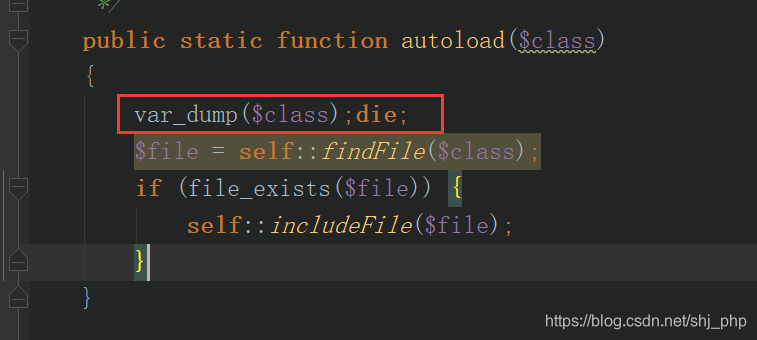spl_autoload_register 函数的功能就是把传入的函数(参数可以为回调函数或函数名称形式)注册到 SPL __autoload 函数队列中,并移除系统默认的 __autoload() 函数。
一旦调用 spl_autoload_register() 函数,当调用未定义类时,系统就会按顺序调用注册到 spl_autoload_register() 函数的所有函数,而不是自动调用 __autoload() 函数。
现在,我们来创建一个 Linux 类,它使用 os 作为它的命名空间(建议文件名与类名保持一致):
<?php
namespace os; // 命名空间
class Linux // 类名
{
function __construct()
{
echo '<h1>' . __CLASS__ . '</h1>';
}
}
接着,在同一个目录下新建一个 PHP 文件,使用 spl_autoload_register 以函数回调的方式实现自动加载:
<?php
spl_autoload_register(function ($class) { // class = os\Linux
/* 限定类名路径映射 */
$class_map = array(
// 限定类名 => 文件路径
'os\\Linux' => './Linux.php',
);
/* 根据类名确定文件名 */
$file = $class_map[$class];
/* 引入相关文件 */
if (file_exists($file)) {
include $file;
}
});
new \os\Linux();
这里我们使用了一个数组去保存类名与文件路径的关系,这样当类名传入时,自动加载器就知道该引入哪个文件去加载这个类了。
但是一旦文件多起来的话,映射数组会变得很长,这样的话维护起来会相当麻烦。如果命名能遵守统一的约定,就可以让自动加载器自动解析判断类文件所在的路径。接下来要介绍的PSR-4 就是一种被广泛采用的约定方式。
=================PSR-4规范==================
PSR-4 是关于由文件路径自动载入对应类的相关规范,规范规定了一个完全限定类名需要具有以下结构:
\<顶级命名空间>(\<子命名空间>)*\<类名>
如果继续拿上面的例子打比方的话,顶级命名空间相当于公司,子命名空间相当于职位,类名相当于人名。那么李彦宏标准的称呼为 "百度公司 CEO 李彦宏"。
PSR-4 规范中必须要有一个顶级命名空间,它的意义在于表示某一个特殊的目录(文件基目录)。子命名空间代表的是类文件相对于文件基目录的这一段路径(相对路径),类名则与文件名保持一致(注意大小写的区别)。
举个例子:在全限定类名 \app\view\news\Index 中,如果 app 代表 C:\Baidu,那么这个类的路径则是 C:\Baidu\view\news\Index.php
我们就以解析 \app\view\news\Index 为例,编写一个简单的 Demo:
<php?
$class = 'app\view\news\Index';
/* 顶级命名空间路径映射 */
$vendor_map = array(
'app' => 'C:\Baidu',
);
/* 解析类名为文件路径 */
$vendor = substr($class, 0, strpos($class, '\\')); // 取出顶级命名空间[app]
$vendor_dir = $vendor_map[$vendor]; // 文件基目录[C:\Baidu]
$rel_path = dirname(substr($class, strlen($vendor))); // 相对路径[/view/news]
$file_name = basename($class) . '.php'; // 文件名[Index.php]
/* 输出文件所在路径 */
echo $vendor_dir . $rel_path . DIRECTORY_SEPARATOR . $file_name;
通过这个 Demo 可以看出限定类名转换为路径的过程。那么现在就让我们用规范的面向对象方式去实现自动加载器吧。
首先我们创建一个文件 Index.php,它处于 \app\mvc\view\home 目录中:
<?php
namespace app\mvc\view\home;
class Index
{
function __construct()
{
echo '<h1> Welcome To Home </h1>';
}
}
接着我们在创建一个加载类(不需要命名空间),它处于 \ 目录中:
<?php
class Loader
{
/* 路径映射 */
public static $vendorMap = array(
'app' => __DIR__ . DIRECTORY_SEPARATOR . 'app',
);
/**
* 自动加载器
*/
public static function autoload($class)
{
$file = self::findFile($class);
if (file_exists($file)) {
self::includeFile($file);
}
}
/**
* 解析文件路径
*/
private static function findFile($class)
{
$vendor = substr($class, 0, strpos($class, '\\')); // 顶级命名空间
$vendorDir = self::$vendorMap[$vendor]; // 文件基目录
$filePath = substr($class, strlen($vendor)) . '.php'; // 文件相对路径
return strtr($vendorDir . $filePath, '\\', DIRECTORY_SEPARATOR); // 文件标准路径
}
/**
* 引入文件
*/
private static function includeFile($file)
{
if (is_file($file)) {
include $file;
}
}
}
最后,将 Loader 类中的 autoload 注册到 spl_autoload_register 函数中:
<?php
include 'Loader.php'; // 引入加载器
spl_autoload_register('Loader::autoload'); // 注册自动加载
new \app\mvc\view\home\Index(); // 实例化未引用的类
/**
* 输出: <h1> Welcome To Home </h1>
*/
===================================================================================
说明:

当new \app\mvc\view\home\Index()实例化一个不存在对象时,会自动调用Loader::autoload方法,并将把 "app\mvc\view\home\Index"作为参数传递给autoload方法,所以:
这里打印的时候可以打印出参数
string(23) "app\mvc\view\home\Index"
来源:CSDN
作者:hello php
链接:https://blog.csdn.net/shj_php/article/details/104015610
